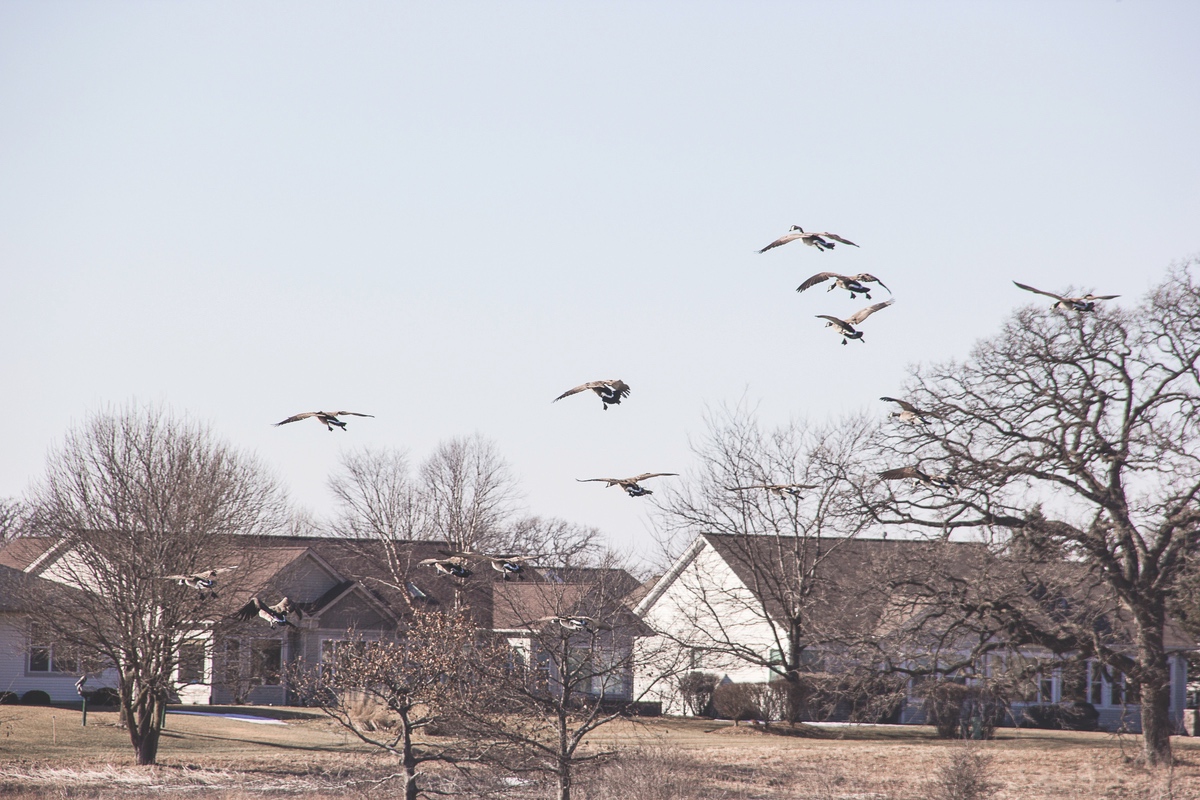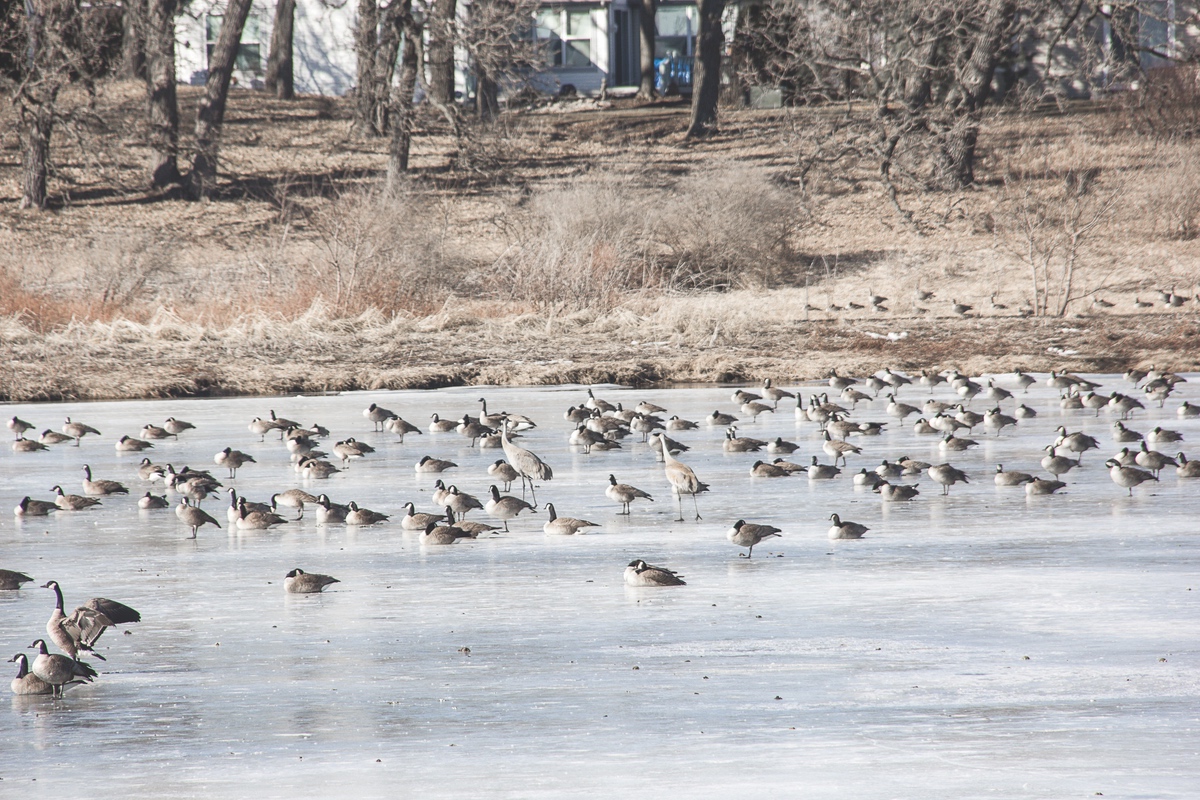The current population of Huntley is reported to range from about 27,000 to 28,500. That includes about 27,000 humans, and anywhere from a few to 1,500 other residents depending on the time and season.
Who are the ”other residents”?
They are geese. We’re talking wildlife biology language here.
The Sun Day, and many other human residents of the community, have noticed large numbers of geese in the village in recent months, particularly in Sun City. Huge recoveries of Canada Geese populations have occurred throughout the U.S.
A document by area wildlife biologists obtained by the Sun Day said, “There were an estimated 3.6 million Canada Geese in North America in 2008.” That number has increased significantly in the last decade. In fact, geese almost became extinct about a century ago, because of over-hunting, lack of legal protection, and habitat loss.
Now, they are back, and in huge numbers. And northern Illinois and the northwest suburbs of Chicago are one of their most popular resting places. Seventy-five years ago, they were rarely seen or found. Today, they are so numerous that in many cases they are considered a nuisance. Local governments have hired and trained dogs to chase or scare the birds away, with mixed results. In rare cases, permits have been issued to kill them
What’s going on here? Where do these geese come from? Do they survive our cold, sometimes sub-zero winters? Don’t they “fly south” to get out of the cold? Where are their nests? Are they protected? Aren’t they in frequent danger of predators?
Sun City parties and neighborhood gatherings frequently feature questions, complaints, and curiosity about geese.
In Sun City, large numbers of geese, sometimes numbering in the hundreds, can be seen on the Whisper Creek Golf Course, on Wildflower Lake (particularly in cold weather) in common areas with expansive areas of landscaped grass, in or near water hazards on golf courses and detention ponds. If residents don’t see them, they hear them. Noisy flights of geese, flying over rooftops in well-organized and loud formations, are seen constantly. Biologists believe the birds communicate in flight about formations or destinations.
The Sun Day spent some time recently with wildlife biologists, talking about geese in general and specifically in and around Sun City. Two area experts were especially helpful – Cindi Jablonski, wildlife ecologist at the McHenry County Conservation District in Woodstock. She works primarily at the district’s Glacial Park Conservation Area near Richmond. Valerie Blaine is a wildlife biologist with the Kane County Forest Preserve District in Elgin.
In fact, Sun City, in the last 20 years, has become one of the favorite habitats of geese in northern Illinois. The community is home to one of the largest groups in the Chicago area.
Jablonski provided literature that told this remarkable goose-recovery story.

We all love our landscaped lawns, expansive grassy areas near lakes and in parks, golf courses with attractive fairways and water hazards, detention ponds and fountains in neighborhoods and next to large buildings and corporate parks. Wetlands and marshes abound in our community. Not far away are acres and acres of open farmlands.
Sun City is a beautiful resort for all of us. It’s also an attractive habitat for geese. The former was planned meticulously in advance, and the latter was accidentally created in the process.
All of this began about 15-20 years after World War II. We rebuilt and expanded our communities while wildlife managers unexpectedly found wild and captive flocks of geese scattered throughout the land. Experts bred birds in captivity and relocated them throughout the U.S.
Once migrants, Canada geese found new habitats everywhere and settled down. Blaine put it crisply in one email to the Sun Day: “Geese settle down in our neighborhoods because they can. They don’t migrate any more because they don’t have to.”
Appropriately, the geese that now live with us are called “resident geese.” They will, however, move around occasionally to avoid bad weather, particularly winter blizzards.
Geese are grazers and love grass, especially fertilized lawn grass. They forage in areas with open sight lines with access to water, where they can see and escape predators, particularly coyotes. Federal law protects geese. It is illegal to harm geese, their eggs, or their nests in the U.S. without permission. They may be harassed or scared away from a certain area with a permit as long as the geese, nests, and eggs are not harmed.
There are two sides to any geese story, however. The Wildlife Services division of the U.S. Department of Agriculture puts it this way: “Canada geese are enjoyed by birdwatchers, sportsmen and women, outdoor enthusiasts, and citizens. However, in some areas, Canada geese can damage property, impact agriculture, pose disease threats, and present public safety problems.” In short, some regard geese as majestic waterfowl, others see them as overbearing, annoying, messy pests. If you have to clean up after them, you probably feel differently than if you just watch them fly by.
With the exception of the Whisper Creek Golf Course, Sun City has welcomed the large birds. In its 20-year history, community management has never taken action against geese, such as modifying habitat areas, harassment by dogs, etc. Dennis O’Leary, president of the community board of directors, said, “I don’t believe we’ve ever felt it necessary to chase them away from any areas or harass or control them in any way,” he said.
The Fox Valley Park District, which includes areas on or near the Fox River, has for the past eight years used teams of border collies to shoo geese away from parks and popular public areas. Many municipal officials and biologists do warn people to avoid getting too close to geese nesting areas.
“Geese sometimes will attack with a kick or bite if you get too close to their nests and goslings,” said Jablonski.
Groups of geese, occasionally will camp out on golf course fairways and greens. Andy Weadge, superintendent of the Whisper Creek course in Sun City, says, however, that cleaning up after the birds is part of the cost of managing the course. “They have plenty of lakes and ponds and farm land around here, so we don’t see them on our course that often. They’re annoying and messy, but not frequently or in a very bad way,” he said.
The Sun Day asked Jablonski if the geese survive the cold winters in Illinois, such as the 45-below zero wind chills we experienced in February of this year.
“They survive, because they are well-fed and fat, with lots of feathers and body fat,” she said.
Geese and humans, living together harmoniously. Take notes, world.





